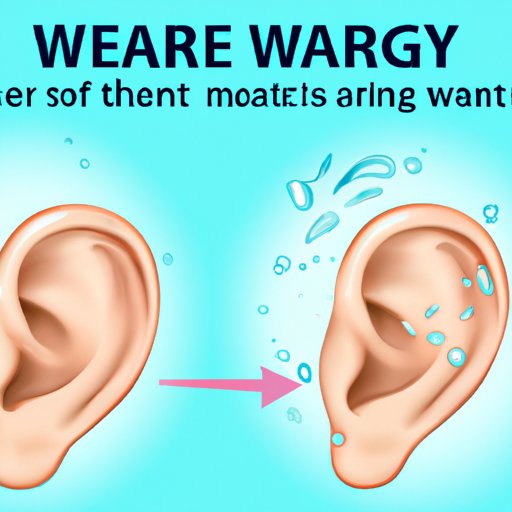
Introduction
Have you ever experienced the discomfort of having water stuck in your ear after swimming? This is a common problem that can affect anyone, from professional swimmers to casual pool-goers. When water gets trapped in the ear canal, it can cause a feeling of fullness, itching, pain, and even temporary hearing loss. Thankfully, there are several easy and effective ways to get water out of your ear. In this article, we’ll show you how to solve this problem using simple techniques you can do at home.
Use Gravity
One of the simplest ways to get water out of your ear is to use the natural force of gravity. This technique works especially well if the water is located in the outer part of the ear canal. Here’s how to do it:
- Lie down on your side with the affected ear facing downward. You can also tilt your head to the side while sitting or standing.
- Gently tug on your ear lobe to help release the water.
- Stay in this position for a few minutes to allow the water to drain out. You can use a towel or tissue to catch any drops.
If the water doesn’t come out on the first try, repeat the process a few times until you feel relief.

Create a Vacuum
If the water is located deeper inside the ear canal, you can create a vacuum to help it come out. Here’s how:
- Place the palm of your hand flat against your ear, forming a seal.
- Press your palm inward and outward rapidly, like you’re clapping your ear.
- Remove your hand and tilt your head to the side to let the water drain out. You may hear a popping sound as the vacuum breaks.
This technique can be especially helpful if you’ve been diving or swimming in a pool with intense pressure changes.

Use a Hairdryer
If the above techniques don’t work, you can try using a hairdryer on low heat to evaporate the water from your ear. Here’s how:
- Turn on your hairdryer on low heat and hold it a few inches away from your ear.
- Aim the air flow at your ear and move the dryer in a sweeping motion.
- Stop if you feel any discomfort or the heat becomes too intense. Never use a hairdryer on high heat or directly pointed into the ear.
It’s important to use caution when using a hairdryer, as heat can damage your ear canal and cause burns if not handled properly.

Try Steam
If you prefer a more natural approach, using steam can help open up your ear canal and release trapped water. Here’s how:
- Boil a pot of water and remove it from the heat.
- Place a towel over your head and lean over the pot, keeping your face about a foot away from the water.
- Breathe in the steam for a few minutes with the affected ear facing downward.
- Repeat a few times until you feel the water draining out. Be careful not to burn yourself with the hot steam or water.

Use a Mixture of Warm Water and Vinegar
A combination of warm water and vinegar can help break down wax buildup and release trapped water. Here’s how to use this method:
- Mix equal parts of white vinegar and warm water in a bowl or cup.
- Fill a dropper or syringe with the solution.
- Lie down on your side with the affected ear facing upward.
- Gently insert the dropper or syringe into your ear canal and squeeze a few drops of the solution into your ear.
- Wait for a few minutes before sitting up and letting the solution drain out. You may need to tilt your head to let it all out.

Use Ear Drops
There are over-the-counter ear drops specifically designed to help dry up water in your ear, such as Swim-Ear or Aqua-Ear. Here’s how to use them:
- Tilt your head to the side with the affected ear facing upward.
- Follow the instructions on the ear drop package, usually involving placing a few drops into your ear canal.
- Lie down on your side with the affected ear facing downward to let the drops work.
- After a few minutes, tilt your head to the side to let the drops and water drain out.

Conclusion
Getting water stuck in your ear can be a frustrating and uncomfortable experience, but thankfully there are several simple techniques you can use to get rid of it. Using gravity, creating a vacuum, using a hairdryer, trying steam, using a mixture of warm water and vinegar, and using ear drops are all effective methods to try. Remember to use caution and follow safety guidelines when using these techniques, and seek medical help if the problem persists. To prevent water from getting trapped in your ear, try wearing ear plugs while swimming and avoiding diving or jumping into the water.




